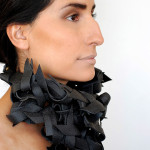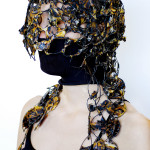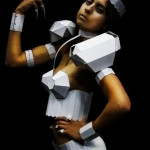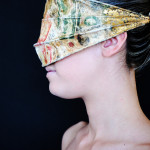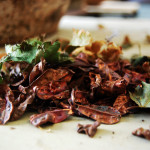Blurring Borders
By Riddel Nigma
Riddel: What themes do you explore in your work? Do you think it’s hard to communicate messages through jewelry?
Haydee: I’ve dealt with subjects as varied as global warming, personal conflicts, to simple mundane life predicaments. Jewelry is such a broad range of things, from an engagement ring to a piece such like “Self Contained.” It’s quiet tricky to portray a message in any medium, jewelry isn’t any different.
R: How did living in the border affect the way you look at art?
H: We have all been forced to alternate between cultures and customs. It’s involuntary to face the problems of both countries equally. While my works for the body do not focus solely on the United State’s economic crisis, or Mexico’s fraud of a presidential election, problems from both sides of the border influence my creative process in a conscious and subconscious manner.
R: Is this what led you to create your award winning piece “Ni Una Mas”?
H: “Ni Una Mas” relates to “the dead women of Juarez.” Growing up the newspaper would depict explicit pictures of these young newcomer maquiladora workers that would end up in vacant lots, lying amidst tin cans, diapers, and car tires. The neckpiece of tightly woven rubber was created to emulate the feeling of asphyxiation with the debris in which these women were camouflaged. My intention is to honor and remember these unfortunate victims.
R: Not only do you do art for the body but have actually transformed your own body into a piece. Do you feel this is a natural progression of the medium?
H: I don’t know if I would call it a natural progression, but jewelry is constantly making me think about the body and its relationship to it. Leaving the jewelry out turned out to be an interesting approach.
R: With your performance piece “I Just Want to be Loved” you fully exposed yourself both physically and emotionally. How did it make you feel then? How do you feel about it now?
H: In a word, “raw.” I wanted to create a piece that was beautifully grotesque. I dieted, dressed up, used proper language, wrote, and recorded journals for the duration of the performance. It was important to make it personal yet still be accessible to my audience. I took four pictures of myself, naked, every day for a month. This image of a nude body became exactly that, just an image. After a while I didn’t feel I was exposing myself, I had become the medium. I believe it my most successful piece to date. When people listened to my recordings they would say, “This isn’t right, I feel like I shouldn’t be listening to this.” It always makes me smile when I think about this piece; it has a deep connection to myself.
R: One of your performances involved a self-injury of sorts; do you feel such an extreme necessary to effectively convey the message?
H: The pain inflicted upon myself in this particular piece was vital. “Gita” is a sacred song characterized by a belief in reincarnation and liberation from earthly evils. Through the ritual of piercing, I reclaimed my body from an indecent assault. I healed my wounds.
R: I understand that you’ve traveled since you got your BFA from UTEP. Where have you gone? How have your travels helped you grow as a person and as an artist?
H: I wanted to continue on to graduate school, but didn’t feel quite ready yet. So immediately after graduation I went to Bodh Gaya, India for 5 months where I lived with Burmese monks as a volunteer. I taught them English and Spanish, and in return they enlightened me about Theravada Buddhism, their culture, their way of life, and more importantly myself. I’ve become a more patient person and have learned that positive thinking will bring positive results. I have absolutely no idea how this will affect me artistically but I’m sure it will manifest itself just like my semester abroad in Paris has.
R: Do you feel like you’re ready to pursue your graduate degree now? Have you been accepted anywhere?
H: Yes I do! I applied to about four different programs in five different school each, performance art, fiber, even fashion, and of course metalsmithing. I am lucky enough to have been accepted into the five schools I applied, but chose the Royal College of Art in London above the rest.
R: What an amazing opportunity to have been accepted into such a prestigious school! Are you ready to make the transition?
H: Of course I’m ready to make the move, but there are quite a few things that need to happen prior to. (From my visa, to finding accommodations, health insurance, and loads and loads of loans) I’m in the process of selling my car and my studio and am still working full time as a waitress. There’s still a tremendous gap of money that needs to be filled. As a result I’ve started a fundraiser. I realize that loans are inevitable but I’m trying to soften the blow if possible.
R: It’s been a pleasure talking with you. Where might someone donate to your campaign? Is there some place where we can see your work?
H: Of course! “Ni Una Mas” and “Nature is Worth More Than a Human Being … It’s Worth More Than 1,000,000 of Them” are part of the permanent collection of the Stanlee and Gerald Rubin Center for the Visual arts. I also have a website: http://cargocollective.com/haydeealonso
This is the website for my campaign is: https://fundrazr.com/campaigns/3V1N3
Photographs courtesy of Haydee Alonso


